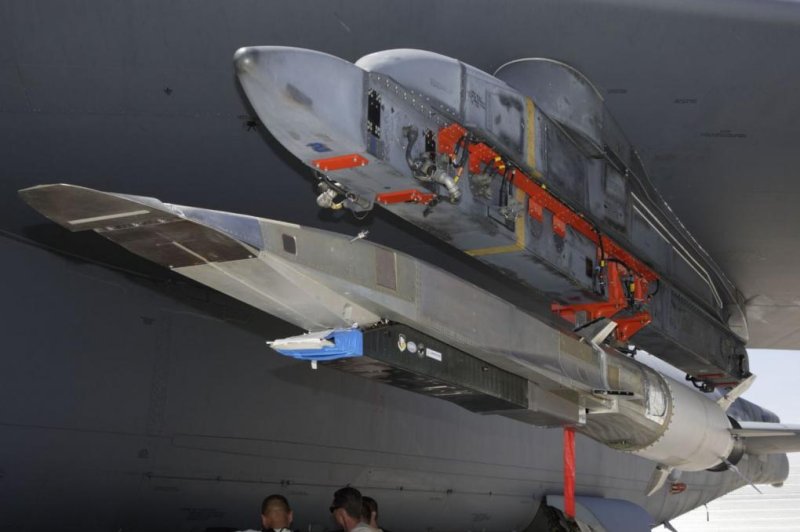An X-51A WaveRider hypersonic flight test vehicle is uploaded to an Air Force Flight Test Center B-52 for fit testing at Edwards Air Force Base on July 17, 2009. Photo courtesy of U.S. Air Force/Chad Bellay
July 29 (UPI) -- Raytheon Co. on Monday announced a successful design review of the Tactical Boost Glide hypersonic weapons program.
The review was conducted in conjunction with the Defense Advanced Research Projects Agency, the arm of the Defense Department responsible for development of emerging technologies for military use.
Hypersonic vehicles operate at high altitude and at speeds up to five times the speed of sound. A boost glide weapon uses a rocket to accelerate its payload and achieve hypersonic speeds, before the payload separates from the rocket and glides to its target, according to Raytheon. The proposed weapons offer engagement from longer distances, shorter response times and greater effectiveness.
"We understand the urgency of the need and are working fast to deliver this advanced technology to our nation's military," Dr. Thomas Bussing, Raytheon Advanced Missile Systems vice president said in a press release. "The goal is to keep America ahead of emerging threats, and we are well on our way."
The Pentagon's budget request for Fiscal Year 2020 for all hypersonic-related research is $2.6 billion, including $157.4 million for hypersonic defense programs, a 26-page report by the Congressional Research service, sent to Congress on July 11, indicates.
"After nearly a decade of chronic underfunding, our military can no longer be counted on to have the best of everything. China and Russia have passed us up in long-range precision fire, hypersonic weapons and other key investments," Sen. James Inhofe, R-Okla., said on July 27 in praise of the budget bill and its inclusion of funding for hypersonic weapons.
A similar weapon developed by Boeing and Israel Aerospace Industries, the Arrow-3 air defense system, recently passed a live interception test in Alaska, the Israeli Defense Ministry said on Sunday. The missile, designed as a defense mechanism against the ballistic missiles in Iranian and Syrian stockpiles, can shoot down missiles in space at an altitude that would safely and effectively eliminate any non-conventional warheads.
Raytheon was awarded a $63.3 million contract to further develop the Tactical Boost Glide hypersonic weapons program. In June, the U.S. Air Force successfully tested a hypersonic air-to-ground weapon prototype carried by a B-52H bomber at Edwards AFB, Calif.















